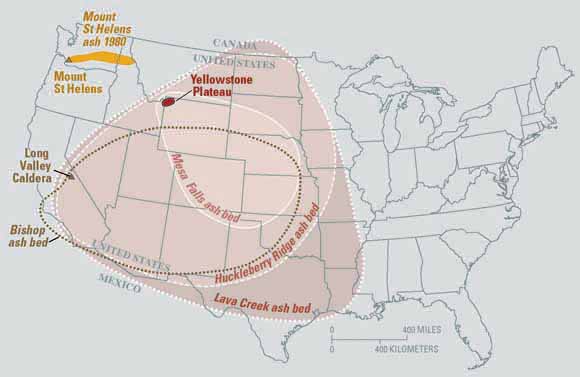Exceptionally large magma pools are ephemeral and cannot exist very long without erupting.
In other words, supervolcanoes can erupt with pretty much zero warning!

The fact that the process of magma body formation occurs in historical time, instead of geological time, completely changes the nature of the problem.
A single volcanic eruption wiping out life on entire continents isn’t exactly a cheery thought, but at least we had the mild comfort that it would take as much as 200,000 years for one to erupt.
However a scientific study shows that the magma pool at the supervolcano site of Long Valley in California erupted within as little as hundreds of years of forming, about 760,000 years ago, and would have covered half of North America in its ash.
There’s only a handful of known supervolcanoes capable of destruction on near-planetary levels – the one beneath Yellowstone National Park is the most famous – but even just a handful of such volcanoes have done plenty of damage. There’s the Toba Event some 70,000 years ago, in which an Indonesian supervolcano affected climate patterns in Africa severely enough that humans almost went extinct.
And then there’s the Long Valley eruption that took place in California some 760,000 years ago. The eruption buried much of North America in thousands of cubic miles of ash and devastated countless ecosystems. The scale of the Long Valley eruption is unlike anything humanity has witnessed in it entire history, and the question Vanderbilt researcher Guilherme Gualda and his team set out to answer was just how much warning we could expect for the next Long Valley type eruption.
Previous research has focused on the formation of zircon crystals inside the supervolcanoes. Using trace radioactive elements from these crystals, scientists had deduced that the initial formation of the magma pools and the resultant supervolcano eruptions were separated by some 200,000 years. If that’s the case, then even the most rudimentary monitoring of these supervolcanoes would tell us whether humanity has anything to worry about from these volcanoes for the next several hundred centuries.
But the Vanderbilt team’s research focused instead on quartz crystals that started forming along with the magma pools and stopped developing once the eruption occurred. Our knowledge of quartz formation is well enough advanced for Dr. Gualda and his team to come up with a revised estimate for the time it takes supervolcanoes to form and erupt. If the quartz crystals are anything to go by, we’re looking at just 500 to 3000 years between when the magma starts collecting and when the supervolcano has to blow.
Obviously, that’s a massively different result from what the zircon had suggested, and further study is needed to figure out just why there’s such a massive discrepancy between the two data sets. But as Dr. Gualda explained to BBC News, if the quartz results do stand up, supervolcanoes have just become a much realer concern to humanity – if not in 2012, then possibly as soon as 2512…and that’s assuming there aren’t any magma pools currently forming!












[…] Supervolcanoes like Yellowstone can form fast and erupt within hundreds of year. supervolcanoes can erupt with pretty much zero warning. Bad news. Article by supervolcanos – Google Blog Search. Read entire story here. […]